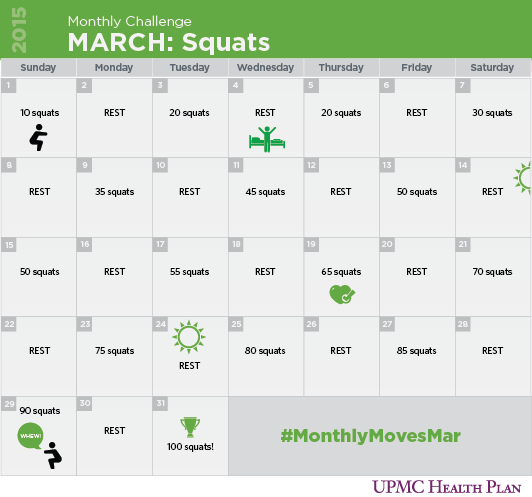30 Day Squat Challenge
Welcome to the March Monthly Squat Challenge! I absolutely love squats because they are a compound movement. This means that it involves multiple joints- the hip and knee joint. Muscles targeted are the quadriceps and the gluteus maximus. Squatting also helps with other areas too like core strength and balance so it’s a no brainer for anyone looking to build strength and stability!
This challenge starts out low in volume for beginners, but those of you experts out there; feel free to do a variation to add intensity to the challenge. You can add weight; make it a plyometric exercise, or even increase the volume. If the starting repetitions are too low you can add a base repetition and each set throughout the month to scale it. Have fun and make it challenging!
 Download a printable version here.
Download a printable version here.
Below is a step by step for squats. Remember, as you get stronger you can move on from a basic squat onto some of the others listed below. You will have a rest day built in every other day to rest and recover for the next repetition increase, so feel free to really challenge yourself on this one!
Always remember to check with your doctor before starting a new physical activity program. While exercise is recommended for almost all individuals, there are certain conditions that can be worsened by specific types of exercise. Remember to always stop if you feel pain or have any unusual symptoms.
Step By Step:
To Start:
-
- Stand with your feet a little wider than shoulder width apart.
- Your toes should be pointed slightly outward with your head forward looking at a spot on the wall throughout the entire exercise.
- You want a strong base. This means your weight should be in your heels and not your toes. Give them a little wiggle just to make sure.
- Arms can be in several positions- out in front with palms face down and bent at the elbows, or behind your head being careful not to pull on the neck.
- Next, take a deep breath and flex your knees and hips to sit back in your hips. Visualize sitting back into an imaginary chair. As you move through the movement, keep your head forward and back straight.
- Lower you’re squat so your thighs are parallel to the floor (or as close as possible depending on flexibility). Stop when your knees reach a 90-degree angle and avoid extending your knees past your ankles, which could cause injury.
- Finally, engage your core, exhale and push through your heels to get back to the starting position. Make sure to focus on squeezing your glutes and driving your hips up.
- Repeat
There are several variations you can do depending upon your strength and experience.
- Body weight squat: This is your basic squat and the easiest place to start.
- Sumo squat: This variation uses a wider stance with toes pointed slightly outward.
- Jump Squat: If you are looking for a higher intensity squat, this plyometric option is for you! You take the basic squat up a notch by adding a jump. Lower yourself into the squat position about half way and then jump up and make sure to land on both feet.
- Goblet squat: In this exercise you simply add a weight such as a dumbbell close to your chest as you perform the exercise. Remember to maintain proper form with the weight added. If you can’t maintain proper form, reduce the weight or go back to the body weight squat.
- Back squat: Once you have mastered a body weight squat you can try adding weight. Take your basic squat and add a barbell across your shoulders and upper back or dumbbells to your sides.
- Front squat: In this variation the barbell is in front of your shoulders with your fingertips under the bar and back towards you. You may find this one really challenging so master the weighted squat first.
Join in the challenge and show us your progress. Tag your photos on Instagram and Twitter with #MonthlyMovesMar
Looking for more monthly challenges? Here’s last month’s sit-up challenge.



